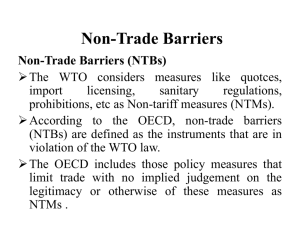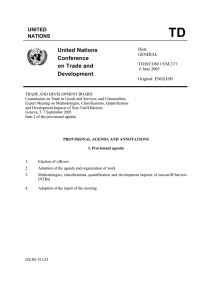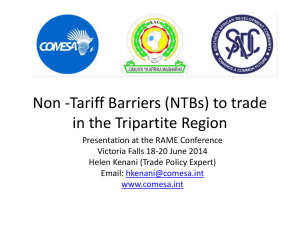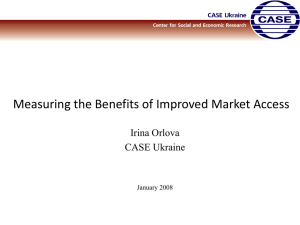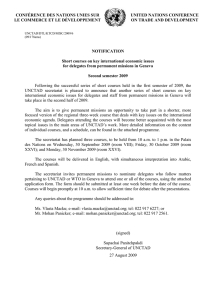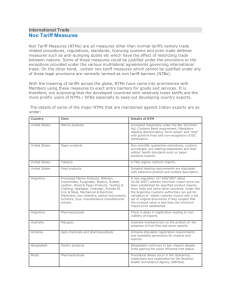TD United Nations Conference
advertisement
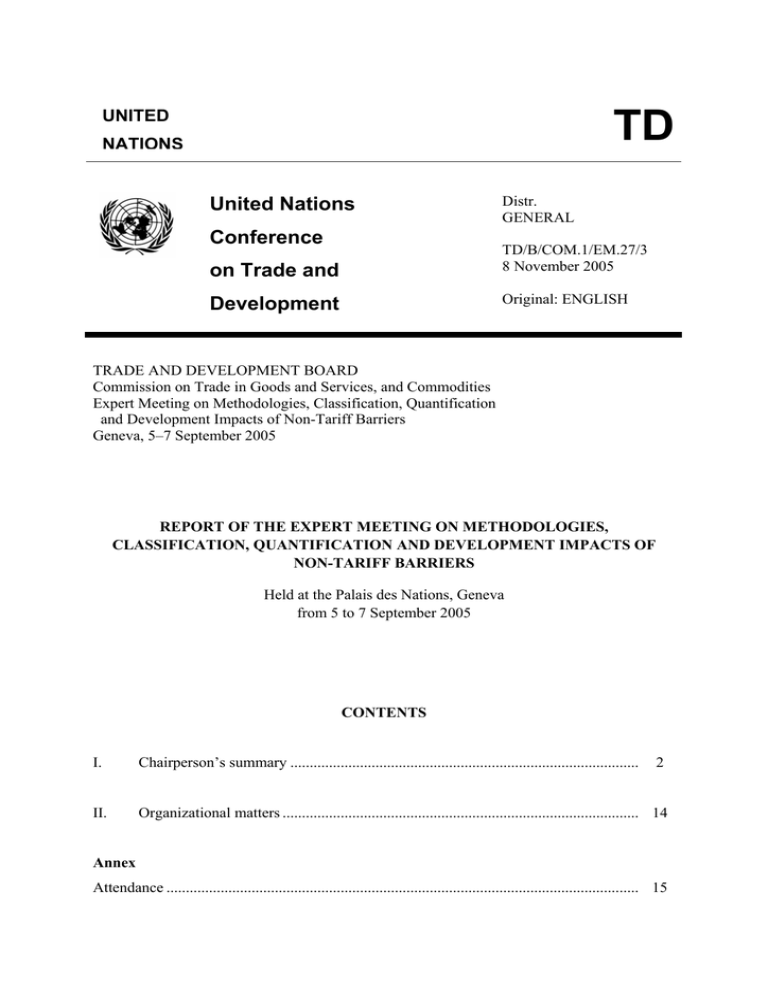
TD UNITED NATIONS United Nations Conference Distr. GENERAL TD/B/COM.1/EM.27/3 8 November 2005 on Trade and Original: ENGLISH Development TRADE AND DEVELOPMENT BOARD Commission on Trade in Goods and Services, and Commodities Expert Meeting on Methodologies, Classification, Quantification and Development Impacts of Non-Tariff Barriers Geneva, 5–7 September 2005 REPORT OF THE EXPERT MEETING ON METHODOLOGIES, CLASSIFICATION, QUANTIFICATION AND DEVELOPMENT IMPACTS OF NON-TARIFF BARRIERS Held at the Palais des Nations, Geneva from 5 to 7 September 2005 CONTENTS I. Chairperson’s summary .......................................................................................... 2 II. Organizational matters ............................................................................................ 14 Annex Attendance .......................................................................................................................... 15 TD/B/COM.1/EM.27/3 Page 2 Chapter I CHAIRPERSON’S SUMMARY Introduction 1. The Commission on Trade in Goods and Services, and Commodities at its ninth session (in Geneva on 14–18 March 2005), while acknowledging that UNCTAD should examine the effects of non-tariff barriers, decided, in accordance with the São Paulo Consensus, to convene an Expert Meeting on Non-Tariff Barriers (NTBs). The São Paulo Consensus, in paragraph 77, provided that efforts to extend market access liberalization for non-agricultural products under the Doha work programme should be intensified so as to reduce or, as appropriate, eliminate, inter alia, non-tariff barriers, in particular on products of export interest to developing countries. 2. The Expert Meeting on Methodologies, Classifications, Quantification and Development Impacts of Non-Tariff Barriers, held in Geneva from 5 to 7 September 2005, addressed a comprehensive agenda related to NTBs and was attended by numerous government officials at the senior and expert level from developed and developing countries and countries with economies in transition, by leading academics, and by representatives of intergovernmental organizations and non-governmental organizations (NGOs). 3. The meeting's focus was primarily on technical and research issues (such as classification and quantification of NTBs) and on forming and strengthening partnerships with relevant international organizations and other stakeholders to deal with NTBs on a comprehensive and long-term basis. 4. Dr. Supachai Panitchpakdi, the Secretary-General of UNCTAD, in his opening statement said that the importance of NTBs as protective and regulatory trade instruments had been increased by the continual decline of tariff rates as the result of eight GATT rounds of multilateral trade negotiations. With such tariff liberalization, NTBs are increasingly becoming front-stage market access concerns. He expressed his intention to shortly establish a Group of Eminent Persons on NTBs drawn from governments, international organizations, academia and civil society. 5. Dr. Alan Deardorff, Professor of Economics and Public Policy at the University of Michigan (United States), delivered a keynote address. He outlined the need to understand systematically the concept (including classification and quantification), measurement and implications of NTBs in the context of supporting UNCTAD's efforts to strengthen its work related to multiplying gains from the international trading system for developing countries. In his opinion, UNCTAD's Trade Analysis and Information System (TRAINS) database epitomized the inventory method and provided the most complete data publicly available on known and acknowledged NTBs. UNCTAD should continue its leadership role in the areas of TD/B/COM.1/EM.27/3 Page 3 NTBs data collection and dissemination. The TRAINS database was an invaluable resource for addressing various stakeholders' needs, and it should be updated. 6. In addition to the experts nominated by member States, 21 persons recognized internationally as authorities on NTBs (including from the WTO, the World Bank, the IMF, ITC, UNIDO, FAO and OECD) served as panellists and made presentations. 7. 8. The key objectives of the meeting were to: • Assist developing countries, including LDCs, in building their analytical and statistical capacity to assess NTBs affecting their exports; • Provide an international forum for researchers and policy makers involved in NTBs to clarify several key methodological, classification and technical issues, including ways of quantifying NTBs to better understand their impact on international trade; • Contribute to the Doha round’s Negotiating Group on non-agricultural market access (NAMA), particularly by concentrating on NTBs of concern to developing countries and by aiming at consensus building for a better understanding of options available in pursuing further trade liberalization after the anticipated decline in importance of classical tariffs and related policy instruments; • Discuss a possible inter-organizational “master plan” for the medium and longer term to invest intellectual, technical and financial efforts in substantially improving knowledge of NTBs and research on their impact on international trade; • Form partnerships between UNCTAD, other international organizations, the donor community, academia and NGOs to improve the database and upgrade research on NTBs, as well as helping developing countries, including LDCs, to deal with NTBs; and • Contribute to UNCTAD's overarching task of upholding an open, equitable, rule-based, predictable and non-discriminatory multilateral trading system, as underlined by the UN Millennium Declaration, as well as to assuring development gains from international trade and trade negotiations. The following text summarizes the comments and suggestions made at the meeting. Scope, definition and classification of NTBs Evaluation of UNCTAD's TCMCS and TRAINS 9. It was widely recognized that UNCTAD's Coding System of Trade Control Measures (TCMCS) remained the most comprehensive international classification system available for NTBs. At its most detailed level, the current classification identified over 100 different types of NTBs. It comprised six categories of NTBs, including price control measures, finance measures, automatic licensing, quantity control measures, monopolistic measures and technical measures. TD/B/COM.1/EM.27/3 Page 4 10. It was acknowledged that UNCTAD's TRAINS database was the most complete collection of available information on NTBs. This database was the result of close collaboration with regional organisations such as ALADI, SIECA and SAARC, as well as with the Inter-American Development Bank. Among these partner organizations, ALADI had developed a comprehensive database of its member countries' NTBs, from which data were drawn for inclusion in TRAINS. However, TRAINS needed further improvement in terms of coverage and data quality and should be updated regularly. 11. The following limitations of TRAINS were highlighted: • The database was based only on information obtained from the importing country, which was insufficient to describe the real situation in any given country. It was suggested that exporting countries (specifically exporters' notification complaints) be considered an additional source of information. • Some NTBs were applied at a level more aggregated than a tariff line, making it difficult to identify exactly which products were affected by the measure. • Some measures were provided at a level less aggregated than a tariff line, without a specific indication of the products not covered by the measure. • The data did not indicate the degree of restrictiveness of an NTB. Work and experiences of governments and international organizations 12. Many governments were making efforts to set up and maintain their national databases on NTBs. In many cases, TCMCS and TRAINS were used as points of reference. For developing countries, especially LDCs, the major challenge was to identify NTBs in specific terms, collect and classify NTB-related information systematically, and measure their impact on trade. 13. Several international organizations also collected information on NTBs. Some organizations specialized in specific types of NTBs. For example, FAO focused on sanitary and phytosanitary measures, or SPS, while UNIDO concentrated on technical regulations, standards and conformity assessment, collectively known as technical barriers to trade, or TBT. 14. The meeting was told that, starting in 2006, the WTO would establish a new database on SPS based on notifications by members. However, even this database would not provide complete coverage of implemented SPS measures. WTO notifications on SPS represented only a fraction of existing measures, as countries were not obliged to notify all measures. The WTO collected information on TBT and other NTBs in a similar way – that is, through notifications by members. 15. The activities of specialized agencies such as FAO, UNIDO and ITC were making an important contribution to the work on collecting and disseminating information on NTBs. For example, FAO, following the implementation of the SPS Agreement, had provided TD/B/COM.1/EM.27/3 Page 5 information at the national and international levels about food safety and animal and plant health. ITC was conducting a comparative analysis of international and national standards for SPS-related measures for specific products. 16. It was noted that UNCTAD, in addition to its pioneering work on TRAINS and related matters, had established a consultative task force on environmental measures affecting exports of developing countries and had implemented several country-specific projects on SPS measures to strengthen the capacities of developing countries in that area. Conclusions 17. Participants acknowledged that NTBs were not merely a North-South issue; there were serious NTBs affecting North-North and South-South trade as well. The lack of a commonly recognized international definition and classification of NTBs made researching and analysing NTBs difficult and the results less reliable. Moreover, NTBs directly and indirectly affected export supply capacity building, competitiveness, and market access and entry, especially for developing countries. 18. Therefore, cooperation and concerted efforts among international and regional organizations were crucial to strengthen and improve the collection and dissemination of information on NTBs in order to provide better services to Governments and other users. International and regional organizations should cooperate not only in collecting data but also in building capacity for developing countries. Participants also discussed possible cooperative arrangements among international and regional organizations and stakeholders to share database information and then add it to the TRAINS database. The EU Market Access Database and national databases on NTBs could be useful information sources. 19. Participants agreed that UNCTAD should improve its classification of NTBs – TCMCS – by identifying and adding new NTBs, thus reflecting a shift from relatively simple NTBs (like quantitative restrictions) to more complex barriers (like technical measures). Technical measures, including SPS and TBT, should be given due importance in the classification, since available estimates indicated that at least 10 per cent of export losses for developing countries as a group resulted from SPS/TBT measures. These measures severely restricted trade, in many cases totally blocking exports. It was also important (although difficult) to distinguish between SPS and TBT measures. 20. Rules of origin were cited as another trade-restrictive barrier that should be incorporated into the classification. Subsidies and other domestic support measures should also be more clearly identified in the classification. Some participants considered it important to include measures that affected trade in services. 21. Several technical solutions to improve TRAINS were identified – for example, providing a more comprehensive description of an individual NTB or including a legal reference and a link to a relevant legal text. It was emphasized that the database should distinguish between measures that were consistent with WTO Agreements and/or other TD/B/COM.1/EM.27/3 Page 6 international norms and those that were not. The database should also adopt the terminology of WTO Agreements, where appropriate. 22. With regard to sources and methods for collecting data on NTBs, it was considered that existing notifications from member countries to international organizations such as the WTO, specialized agencies and regional organizations were useful sources of data. In addition, sources from importing and exporting countries, government and business publications, and independent sources should be taken into account. 23. Participants emphasized that the definition of NTBs remained a problem that needed to be addressed. Major criteria used to define an NTB were its trade-restricting nature and stringency. For example, if a country had a technical regulation or standard that was more stringent than the international norm, this should be considered an NTB with trade-restricting potential. The types of technical regulations and standards were shifting from product-based to process-based ones, and a database based only on product codes would not be able to respond to the new trend. From the viewpoint of trade policy makers and negotiators, comprehensive information was needed in this regard. 24. Participants stressed the importance of (a) strengthening the human and institutional capacities of developing countries, especially LDCs, for collection and analysis of data and information on NTBs, and (b) disseminating information on NTBs in a systematic and userfriendly manner to relevant stakeholders, including exporters. NTB-related data constituted a global public good and should therefore be in the public domain to ensure access and transparency. 25. Participants welcomed the intention of the Secretary-General of UNCTAD to set up a Group of Eminent Persons on NTBs. They also supported the proposal that UNCTAD, working with all concerned international/regional organizations and with the support of donors, establish a network of national focal points in developing countries to improve collection and analysis of data on NTBs. Participants recognized that improvement and updating of the database was a resource-intensive exercise and underlined the importance of strengthening UNCTAD's work in this area in terms of human and financial resources. Quantification of NTBs Current situation 26. It was highlighted that a number of important issues needed to be addressed in order to make quantification of NTBs more productive and useful for policy makers and trade negotiators. From a WTO negotiation perspective, in order to be relevant for trade negotiators, any attempt to collect and quantify NTBs should focus on the reasons for which trade negotiators needed information on NTBs and the types of information needed. The database design and classification adopted should reflect the priorities. Dynamic updating of information was also important, as well as coordination of data collection and dissemination. TD/B/COM.1/EM.27/3 Page 7 27. Several priorities were identified, based on the various stages of negotiations: preparation, actual negotiations, and implementation. In the preparation phase, negotiators would probably use various sources to define the agenda, TRAINS being of course a major source of information on NTBs. NTB-specific expertise was crucial, and relevant experts and databases needed to be ahead of a negotiating process in focusing on issues for the future. It was also argued that at this stage quantification (e.g. ad valorem equivalent, or AVE, calculation) was not indispensable, but was rather useful for defining objectives and strategy. 28. Some participants said that in the negotiating phase, the need for data on NTBs depended largely on the negotiation modality (measure by measure, sectoral, eliminating or disciplining existing measures, etc.), as well as on the negotiating context (reciprocity, single undertaking, special and differential treatment, etc.). Examples were given from the Agreement on Textile and Clothing, the Agreement on Agriculture and the TBT Agreement. The extent of information needed at this stage also depended on the type of NTB under negotiation (e.g. quota utilization, prices and technical regulations). Also, at this stage, negotiations could advance fairly well even with incomplete information and without a systematic quantification of NTBs. However, more information would allow a better negotiating outcome and would ensure a level playing field for developed and developing countries, LDCs in particular. Here TRAINS could play a major role, particularly by taking into account negotiators' needs with regard to database upgrading, in terms of NTB classification and coverage. 29. Issues related to NTB measurement were discussed in detail. It was noted that researchers and negotiators used TRAINS to develop estimates and assessments of impact on trade and economic welfare. Such research would seek to answer questions related to barriers that developing-country exporters faced, and also to identify the level of protection in different goods sectors. Some participants proposed that TRAINS should be able to estimate the trade restrictiveness of individual NTBs. 30. Some participants focused on rules of origin (ROO) as a highly trade-restrictive policy instrument that did not have a clear theoretical basis. Results from various empirical studies revealed that on average ROO were equivalent to a 4 per cent tariff. It was underlined that ROO were likely to represent a major determinant of the value of preferential access to northern markets for developing countries. A growing number of products in world trade were becoming intermediate to final or finished goods. NTBs like the various ROO could have much greater effects on intermediates than on final goods. Problems of overlapping NTBs affecting the same product or group of products also needed addressing. Another challenging task would be to quantify the impacts of barriers on services trade. 31. A key feature distinguishing NTBs from tariffs is their tendency to act as "binary trade barriers". NTBs could, and in many cases did, entirely block the exports of a particular country. This added to other challenging factors in quantifying NTBs, such as the impact on product differentiation (consumer and producer size, quality issues, etc.), as well as various complicating factors associated with imperfect competition. Under these conditions, for NTBs that acted as fixed costs for firms and/or exporting countries, the AVEs needed to be calculated on a bilateral basis (exporting- and importing-country pairs), so that the fixed-cost TD/B/COM.1/EM.27/3 Page 8 effects of NTBs were weighted by the trade flows affected. In such cases, the impact of NTBs on small developing countries and LDCs was likely to be greater. 32. It was also noted that the World Bank study estimated the AVEs of NTBs for 104 countries and about 5,000 product lines. The study concentrated on the overall AVE of NTB (as a group, not by type) and the AVE of domestic subsidies. The quantity impact of NTBs on imports was estimated and then converted into price or tariff equivalents. The World Bank also noted that knowing the AVEs of NTBs would be useful for empirical purposes because the data requirements were reasonable, estimates were relatively straightforward, the final result was rather detailed (on a tariff line basis), the precision of estimates could be assessed, and estimates could be easily aggregated to produce industry/country/overall indexes. The results showed that NTBs were much more restrictive to trade than the existing tariffs, and that the level of NTBs on a country-by-country basis tended to increase with GDP per capita. Thus, TBT were mostly applied by developed countries, while their restrictive effects were felt largely by developing countries. The World Bank study also revealed that protection in agriculture was much higher and resulted mostly from NTB. In general, the variance of NTB across sectors was large. 33. Several participants discussed issues involved in calculating the trade restrictiveness index as a combination of tariffs and NTBs in a country. One participant focused on a methodology using specific tariff and non-tariff indicators to arrive at a composite measurement of trade restrictiveness. This trade restrictiveness index (TRI) had three parts: an overall index, a tariff restrictiveness rating, and a non-tariff restrictiveness rating. The tariff restrictiveness index rated countries on a scale of 1 to 5, based on average MFN applied tariff rates (plus any surcharges). The non-tariff restrictiveness index rated countries on a scale of 1 to 3, based on the prevalence of NTBs. The overall TRI of a country was then computed as the simple unweighted average of the two other indices, with NTBs weighted three times as heavily as tariffs. Other participants described their experiences with measuring the trade restrictiveness of NTBs using their own methodologies and sources, including TRAINS, WTO notifications and the EU Market Access Data Base. The way forward 34. Participants agreed that achieving a clearer understanding of NTBs’ definition and classification was crucial. Equally important was to obtain reliable and detailed data, especially from national-level sources. The latter was considered the biggest challenge. It was also acknowledged that TRAINS should be reorganized to meet the needs not only of LDCs and other developing countries but of all member States. 35. Several participants emphasized that TRAINS should be focused on getting more accurate data on NTBs by type, extensive country and product coverage, and time series data. One participant noted that TRAINS should have better data on domestic support measures. 36. Another important use of AVEs for NTB related to the analysis of economic effects of NTBs in various simulation frameworks, such as partial or general equilibrium models. The size of the estimated economic effects would crucially depend on how AVEs were calculated TD/B/COM.1/EM.27/3 Page 9 and used in these models. This pointed to one possible direction for future efforts to quantify NTBs: more accuracy in AVEs should be obtained on a bilateral basis. However, since this approach could be constrained by data availability, another approach could be to concentrate on partial equilibrium models focusing on a particular product market in a particular country or group of countries and using "handcrafted" estimates, even though in this case policy makers and negotiators would still be missing a broad and comprehensive assessment of the impact of various NTBs. 37. Updating and reorganizing TRAINS would help to classify and then quantify the overall index of protection by country and across time for overall comparisons. The quantification of protection in specific sectors would also help to produce better analysis and negotiate improved market access. The discussion also focused on a limited number of NTBs which were ready for the negotiating phase so far. On the other hand, some participants found that classification of NTBs should be simplified, particularly for negotiating purposes. There was also a pressing need to more clearly define some relevant concepts in the WTO Agreements such as “unnecessary obstacles to trade”. Other participants thought that, to be productive, the Doha negotiations should prioritize a limited number of NTBs. 38. Another issue discussed was the use of economic modelling techniques to estimate the impact of NTBs. A common method for measuring such impact was to compare the internal and external prices of goods subject to NTBs. However, in most cases, information on policy issues involving NTBs was not sufficient. Therefore, a proper understanding of existing price gaps, quality differences, and specific reasons for using NTBs was crucial. In addition, the “benchmark model” for NTBs deserved attention. On the other hand, one participant pointed out the subjective judgements that researchers might make in a modelling exercise. Conclusions 39. It was agreed that a clearer understanding of NTBs’ definition and classification and the availability of reliable and detailed data were prerequisites for reliable quantification, improved analysis and negotiation of better market access. In particular, an important task in the context of TRAINS was to collect more precise and comprehensive data on NTBs, by type as well as in terms of country and time-series coverage. It was emphasized that UNCTAD should be able to maintain a case studies database on various aspects of NTBs (restrictiveness, cost of certification/technical requirements), as well as other inputs needed for the calculation of AVEs for NTBs, such as import demand elasticities. 40. Participants emphasized the need for UNCTAD to make every effort to help developing-country trade negotiators, especially those of LDCs, to build their capacities, thus ensuring their effective participation in the Doha round as well as in regional trade negotiations. In doing so, it was agreed, UNCTAD should sharpen its focus by giving priority to the main NTBs faced by these countries’ exporters in both northern and southern markets. 41. Participants recognized that the effects of given NTBs could be very different for countries at different stages of development. This fact needed to be taken into account in TD/B/COM.1/EM.27/3 Page 10 future work, including in the analysis of the effects of NTBs on supply capacity, competitiveness, and market access/entry conditions. Use of NTBs and concerns of developing countries Current trends in NTB use 42. Participants focused on the Doha development agenda, whose major goals included the elimination of NTBs affecting products of interest to developing countries. Identification of such NTBs was a big challenge for negotiators. At this stage, various approaches were being attempted, including multilateral review, vertical, horizontal and bilateral approaches, and coordination with other negotiating groups and regular WTO committees. Participants stressed the importance of negotiating NTBs at the WTO. Additional reasons for this were (a) to ensure that tariff commitments were not eluded or undermined, (b) to limit trade disputes between WTO Members and (c) to minimize the trade-distorting effects of legitimate nontariff measures. 43. It was emphasized that, in the Doha negotiations, developing countries had been mentioning the importance of addressing NTBs as part of negotiations on NAMA, rules and trade facilitation. Furthermore, they had made a number of specific proposals relating to NTBs in the context of special and differential treatment and implementation-related issues. These proposals should be dealt with constructively and effectively. 44. The recent work by the World Bank on AVEs of NTBs had revealed that higher values were concentrated in developed countries and were very sector-specific. NTBs were found to substantially affect overall trade restrictiveness, and particularly agricultural sectors. These estimates also revealed that NTBs substantially affected trade restrictiveness among developing countries, although the average level of protection was still driven by tariffs. 45. A key issue raised was the distinction between, and the means to distinguish between, a regulatory and legitimate non-tariff measure and a protectionist NTB. Protectionism could be easily identified in the case of de facto or de jure discrimination. Although this type of NTB identification appeared to be straightforward, it might be time consuming. Protectionism could also take the subtler form of a regulation that imposed de facto capacity constraints on all potential exporting countries. In this case, it would be difficult and perhaps undesirable to envisage removal of the measure, as in the case of a discriminatory one. Rather, resources should be devoted to assisting developing countries through a monitoring mechanism, but also through aid to improve export capacity. 46. It was pointed out that, while other forms of intervention could distort trade, very little information was available. Regarding subsidies, extensive information was available only for agricultural sectors. Information on regulations in services sectors related to product distribution and on investment incentives would also help in understanding the pervasive nature of limitations on trade. TD/B/COM.1/EM.27/3 Page 11 Developing countries' concerns 47. LDC and other developing-country participants expressed concern that, because of the lack of understanding of and information about NTBs, they would not negotiate successfully at the WTO. Technical assistance, aid for trade and improved market access were discussed. 48. The OECD had recently analysed NTBs of concern to developing countries. The analysis focused on three questions: what NTBs developing countries faced, which products were affected, and whether the issues differed for North-South and South-South trade. The information sources for this report included data from recent studies and other literature, NTB notifications to NAMA, WTO dispute settlement cases, regional bodies, and business surveys in developing countries. The OECD study concluded that: (a) the most significant sectors affected by NTBs were fishery products, electrical equipment, pharmaceuticals, textiles and clothing, the automotive sector and food products; (b) customs and administrative procedures and TBT were problems mostly for North-South trade; and (c) customs and administrative procedures and charges on imports were problems for South-South trade. 49. Some participants pointed out that NTBs were among the most significant issues developing countries had to tackle in the course of South-South regional economic integration. The framework of the South-South regional trade agreements could play an important role in reducing NTBs. It was suggested that more attention be paid to reducing NTBs under the North-South regional trade agreements. 50. International standards were mentioned as an issue of concern to developing countries. Although technical regulations and standards were legally applied in developed countries, some were incompatible with international standards and others went beyond those standards. For developing countries, meeting international standards was a serious issue. It was acknowledged that developing countries' participation in international standard setting should be improved and strengthened. Conclusions 51. With regard to increased use of antidumping and countervailing measures, participants stressed that additional information should be incorporated into the TRAINS database. In particular, TRAINS should be able to accommodate precise information on antidumping and countervailing measures so as to increase the capability of analytical tools. 52. It was recognized that, in addition to the information on NTBs on intermediate products, TRAINS should eventually focus on trade in services, as world trade in this sector was increasing. Sound information on services would help developing countries to identify specific barriers and their implications for global trade flows. 53. It was emphasized that developing countries' participation in NAMA negotiations on NTB was less active than their participation in tariff negotiations. For all WTO Members, especially developing countries, identifying specific NTBs they were facing in both developed- and developing-country markets was a challenge and an immediate priority. TD/B/COM.1/EM.27/3 Page 12 Recommendations 54. The Expert Meeting recommended that the Commission on Trade in Goods and Services, and Commodities at its tenth session consider the following proposals made by participants with regard to UNCTAD's future work on NTBs: • UNCTAD should improve its current classification of NTBs – TCMCS – by identifying and adding new NTBs. In this context: (a) Technical measures, including the distinction between SPS and TBT measures, should be reflected in the revised classification. (b) Rules of origin, which were also trade-distorting barriers, should be incorporated into the classification. (c) Subsidies and other domestic support measures should be more clearly identified. (d) Every effort should be made to ensure that the database distinguished between measures that were consistent with WTO Agreements and/or other international norms and those that were not. The database should be adapted to the terminology of WTO Agreements, where appropriate. (e) NTBs needed to be clearly defined, bearing in mind that major criteria for defining an NTB were its trade-restricting nature and its stringency. (f) The TRAINS database needed to focus on trade in services. • In the longer term, UNCTAD should focus on better defining, classifying and quantifying NTBs, in cooperation with all relevant international and regional organizations and other stakeholders. In particular, TRAINS required more precise and comprehensive data on NTBs, by type as well as in terms of country- and time-series coverage. UNCTAD should maintain a case studies database on various aspects of NTBs (restrictiveness, cost of certification/technical requirements, etc.), as well as other inputs needed to calculate AVEs for NTBs, such as import demand elasticities. TRAINS should be able to accommodate more precise information on antidumping and countervailing measures in order to improve the capability of analytical tools. • In the short term, UNCTAD should simultaneously make every effort to help trade negotiators of developing countries, especially LDCs, build their capacity to deal with NTB-related negotiating issues, thus ensuring their effective participation in the Doha round and regional trade negotiations. UNCTAD should give priority to the principal NTBs faced by exporters of LDCs and other developing countries in both northern and southern markets. UNCTAD should also continue and improve its analysis of the effects of NTBs on supply capacity, competitiveness and market access/entry conditions. • The Secretary-General of UNCTAD should establish a Group of Eminent Persons on NTBs as soon as possible. In addition, UNCTAD, working with all concerned international/regional organizations and with the timely and sustainable support of the donor community, in particular as part of their "aid for trade" initiative, should establish a network of national focal points in developing countries to improve collection and analysis of data on NTBs. • UNCTAD's work on NTBs should be adequately strengthened in terms of human and financial resources. TD/B/COM.1/EM.27/3 Page 13 55. Participants were asked to complete a questionnaire evaluating the usefulness of the meeting. Of 30 participants who responded, four rated the meeting as "excellent", 19 as "very good" and seven as "good". TD/B/COM.1/EM.27/3 Page 14 Chapter II ORGANIZATIONAL MATTERS Convening of the Expert Meeting 56. The Expert Meeting on Methodologies, Classification, Quantification and Development Impacts of Non-Tariff Barriers was held at the Palais des Nations, Geneva, from 5 to 7 September 2005. Election of officers (agenda item 1) 57. At its opening meeting, the Expert Meeting elected the following officers to serve on its bureau: Chairperson: H. E. Mr. Enrique A. Manalo (Philippines) Vice-Chairperson-cum-Rapporteur: Mr. Emmanuel Farcot (France) Adoption of the agenda (agenda item 2) 58. At the same meeting, the Expert Meeting adopted the provisional agenda circulated in document TD/B/COM.1/EM.27/1. The agenda for the meeting was thus as follows: 1. Election of officers 2. Adoption of the agenda and organization of work 3. Methodologies, classifications, quantification and development impacts of non-tariff barriers (NTBs) 4. Adoption of the report of the meeting Documentation 59. For its consideration of the substantive agenda item, the Expert Meeting had before it a note by the UNCTAD secretariat titled “Methodologies, classifications, quantification and development impacts of non-tariff barriers” (TD/B/COM.1/EM.27/2). Adoption of the report of the meeting (agenda item 4) 60. At its closing meeting, the Expert Meeting authorized the Rapporteur to prepare the final report of the meeting under the authority of the Chairperson. TD/B/COM.1/EM.27/3 Page 15 Annex ATTENDANCE ∗ 1. ∗ Experts from the following States members of UNCTAD attended the meeting: Algeria India Angola Indonesia Argentina Iran (Islamic Republic of) Bangladesh Italy Belarus Jordan Benin Kenya Bhutan Kyrgyzstan Bolivia Madagascar Brazil Malawi Bulgaria Malaysia Burkina Faso Mexico Cameroon Mongolia Canada Nepal China Nicaragua Colombia Oman Cuba Philippines Dominican Republic Poland Ethiopia Republic of Korea Finland Russian Federation France Saudi Arabia Germany Senegal Greece Slovakia Guinea-Bissau Slovenia Haiti South Africa Honduras Spain For the list of participants, see TD/B/COM.1/EM.27/INF.1. TD/B/COM.1/EM.27/3 Page 16 2. Sri Lanka Turkey Switzerland Venezuela (Bolivarian Republic of) Syrian Arab Republic Viet Nam Tajikistan Yemen Thailand Zimbabwe The following intergovernmental organizations were represented at the meeting: African, Caribbean and Pacific Group of States African Union Agency for International Trade Information and Cooperation Economic Community of West African States European Community 3. The following specialized agencies and related organizations were represented at the meeting: International Monetary Fund United Nations Industrial Development Organization World Bank 4. The following non-governmental organizations were represented at the meeting: General Category Oxfam Special Category Center for International Environmental Law TD/B/COM.1/EM.27/3 Page 17 5. The following panellists attended the meeting: Scope, definition and classification of NTBs Mr. Luis Gonzaga, Director, Departamento de Información, Asociación Latinoamericana de Integración (ALADI), Montevideo, Uruguay Ms. Lee Ann Jackson, Economic Affairs Officer, Agriculture Division, WTO, Geneva, Switzerland Ms. Ludivine Tamiotti, Legal Affairs Officer, Trade and Environment Division, WTO, Geneva, Switzerland NTB database structure and development Mr. Rafael Cornejo, Inter-American Development Bank, Washington, DC, United States of America Mr. Otto Loesener Diaz, Industrial Development Officer, Industrial Promotion and Technology Branch, UNIDO, Vienna, Austria Ms. Diane Manifold, International Economist Mr. Mondher Mimouni, Market Analyst, ITC, Geneva, Switzerland Mr. Kazuaki Miyagishima, Secretary, Codex Alimentarius Commission, Joint FAO/WHO Food Standards Programme, Rome, Italy Quantification of NTBs Mr. Marc Bachetta, Counsellor, Economic Research and Statistics Division, WTO, Geneva, Switzerland Mr. Alan V. Deardorff, Professor of Economics and Public Policy, University of Michigan, Detroit, United States of America Mr. David Laborde, Economist, Centre d'études prospectives et d'information internationale, CEPII, Paris, France Mr. Alessandro Nicita, Economist, Development Research Group, World Bank, Washington, DC, United States of America Mr. Stephen Tokarick, Senior Economist, Research Department, International Monetary Fund, Washington, DC, United States of America Current trends in NTB use Ms. Nancy Adams, Senior Counselor/Chief NAMA Negotiator, Permanent Mission of the United States of America to the WTO Ms. Barbara Fliess, Principal Administrator, Trade Directorate, OECD, Paris, France M. Bernard Hoekman, Groupe d'économie mondiale, Institut d'études politiques, Paris, France Development Research Group, World Bank, Washington, DC, United States of America TD/B/COM.1/EM.27/3 Page 18 Mr. Roy Santana, Economic Affairs Officer, Market Access Division, WTO, Geneva, Switzerland Developing countries' concerns Mr. Soulaymane Coulibaly, Economics and International Relations, Nestlé SA, Vevey, Switzerland (representative of the International Chamber of Commerce) Mr. Herson Rodriguez, Director General, Informática, Secretaria de Integración Económica Centroamericana (SIECA), Guatemala Mr. Subash C. Sharma, Economic, Trade and Transport Division, SAARC, Katmandu, Nepal _______
